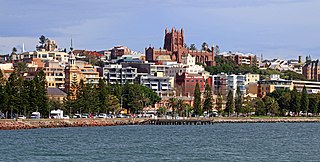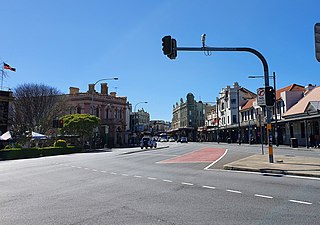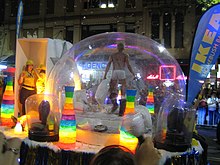
Newcastle or Greater Newcastle, locally nicknamed Newy, is a regional metropolitan area and the second-most-populated district in New South Wales, Australia. It includes the cities of Newcastle and Lake Macquarie; it is the hub of the Lower Hunter region, which includes most parts of the local government areas of City of Newcastle, City of Lake Macquarie, City of Maitland, City of Cessnock, and Port Stephens Council.

The culture of Australia is primarily a Western culture, originally derived from the United Kingdom but also influenced by the unique geography of Australia and the cultural input of Aboriginal, Torres Strait Islander and other Australian people. The British colonisation of Australia began in 1788, and waves of multi-ethnic migration followed. Evidence of a significant Anglo-Celtic heritage includes the predominance of the English language, the existence of a democratic system of government drawing upon the British traditions of Westminster government, parliamentarianism and constitutional monarchy, American constitutionalist and federalist traditions, and Christianity as the dominant religion.

Tamworth is a city and administrative centre of the north-western region of New South Wales, Australia. Situated on the Peel River within the local government area of the Tamworth Regional Council, it is the largest and most populated city in the region, with a population of 43,874 in 2021, making it the second largest inland city in New South Wales. Tamworth is 318 km (198 mi) from the Queensland border and is located almost midway between Brisbane and Sydney.

Wollongong, colloquially referred to as The Gong, is a city located in the Illawarra region of New South Wales, Australia. The name is believed to originate from the Dharawal language, meaning either 'five islands/clouds', 'ground near water' or 'sound of the sea'. Wollongong lies on the narrow coastal strip between the Illawarra Escarpment and the Pacific Ocean, 85 kilometres south of central Sydney. Wollongong had an estimated urban population of 302,739 at June 2018, making it the third-largest city in New South Wales after Sydney and Newcastle and the tenth-largest city in Australia by population. The city's current Lord Mayor is Gordon Bradbery AM who was elected in 2021.

Newtown, a suburb of Sydney's inner west, is located approximately four kilometres south-west of the Sydney central business district, straddling the local government areas of the City of Sydney and Inner West Council in the state of New South Wales, Australia.

Campbelltown is a suburb located on the outskirts of the metropolitan area of Sydney, New South Wales, Australia. It is located in Greater Western Sydney 53 kilometres (33 mi) south-west of the Sydney central business district by road. Campbelltown is the administrative seat of the local government area of the City of Campbelltown. It is also acknowledged on the register of the Geographical Names Board of New South Wales as one of only four cities within the Sydney metropolitan area.

Coogee is a beachside suburb in the Eastern Suburbs of Sydney, New South Wales, Australia, eight kilometres south-east of the Sydney central business district.

West Wyalong is the main town of the Bland Shire in the Riverina region of New South Wales, Australia. Located 467 kilometres (290 mi) west of Sydney as well as being 262 m (860 ft) above sea level, it is situated on the crossroads of the Newell Highway between Melbourne and Brisbane, and the Mid-Western Highway between Sydney and Adelaide.

The Sydney central business district (CBD) is the historical and main commercial centre of Sydney. The CBD is Sydney's city centre, or Sydney City, and the two terms are used interchangeably. Colloquially, the CBD or city centre is often referred to simply as "Town" or "the City". The Sydney city centre extends southwards for about 3 km (2 mi) from Sydney Cove, the point of first European settlement in which the Sydney region was initially established.

London has, alongside New York, been described as the cultural capital of the world. The culture of London concerns the music, museums, festivals, and lifestyle within London, the capital city of the United Kingdom. London is one of the world's leading business centres, renowned for its technological readiness and economic clout, as well as attracting the most foreign investment of any global city.
The Biennale of Sydney is an international festival of contemporary art, held every two years in Sydney. It is a large and well-attended contemporary visual arts event in the country. Alongside the Venice and São Paulo biennales and Documenta, it is one of the longest running exhibitions of its kind and was the first biennale to be established in the Asia-Pacific region.

Australian rules football in New South Wales is a team sport played and observed in the Australian state. It dates back to the colonial era in 1866, with organised competitions being continuous since the 1880s. Today, it is popular in several regions of the state, including areas near the Victorian and South Australian borders—Riverina, Broken Hill, and South Coast. These areas form part of an Australian cultural divide described as the Barassi Line. To the east of the line, it is known as "AFL", named after the elite Australian Football League competition. AFL NSW/ACT is the main development body, and includes the Australian Capital Territory.
Oxford Falls Grammar School (OFG) is an independent Christian co-educational primary and secondary school, located in Oxford Falls on the Northern Beaches of Sydney, New South Wales, Australia.
Sport in New South Wales describes participation in and attendance at organised sports events in the state of New South Wales in Australia. Sport forms an integral part of the culture of the state.

The culture of Melbourne, the capital of the Australian state of Victoria, encompasses the city's artistic, culinary, literary, musical, political and social elements. Since its founding as a British settlement in 1835, Melbourne has been culturally influenced by European culture, particularly that of the British Isles. During the 1850s Victorian gold rush and in the decades that immediately followed, immigrants from many other parts of the world, notably China and the Americas, helped shape Melbourne's culture. Over time, Melbourne has become the birthplace of a number of unique cultural traits and institutions, and today it is one of the world's most multicultural cities.

The National Art School (NAS) is a tertiary level art school, located in Darlinghurst, an inner-city suburb of Sydney, New South Wales, Australia. The school is an independent accredited higher education provider offering specialised study in studio arts practice across various disciplines.
Create NSW is a government agency of the Government of New South Wales, that falls within the Enterprise, Investment and Trade cluster. The agency was created on 1 April 2017 from an amalgamation of Arts NSW (ANSW) and Screen NSW. Create NSW is responsible for administering government policies that support the arts, artists and the various cultural bodies within the state of New South Wales in Australia, and for the provision of funding. It also provides secretarial and administrative support to the Arts & Culture Advisory Committee, a high-level committee which works with the government to help shape policy and promote the arts throughout the state.
Leeds is known for its culture in the fields of art, architecture, music, sport, film and television. As the largest city in Yorkshire, Leeds is a centre of Yorkshire's contemporary culture and is the base for Yorkshire's television and regional newspapers.

Carriageworks is a multi-arts urban cultural precinct located at the former Eveleigh Railway Workshops in Redfern, Sydney, Australia. Carriageworks showcases contemporary art and performing arts, as well as being used for filming, festivals, fairs and commercial exhibitions. The largest such venue in Australia, it is a cultural facility of the NSW Government, and receives support from Create NSW and the Australian Government through the Australia Council for the Arts. The centre has commissioned new work by Australian and international artists, and has been home to eight theatre, dance and film companies, including Performance Space, Sydney Chamber Opera and Moogahlin Performing Arts, and a weekly farmers' market has operated there for many years.

The following outline is provided as an overview of and topical guide to Sydney:





























